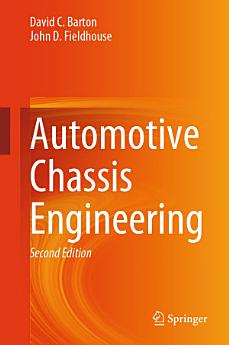Automotive Chassis Engineering: Edition 2
ଜୁନ 2024 · Springer Nature
ଇବୁକ୍
369
ପୃଷ୍ଠାଗୁଡ଼ିକ
reportରେଟିଂ ଓ ସମୀକ୍ଷାଗୁଡ଼ିକୁ ଯାଞ୍ଚ କରାଯାଇନାହିଁ ଅଧିକ ଜାଣନ୍ତୁ
ଏହି ଇବୁକ୍ ବିଷୟରେ
Written for students and practising engineers working in automotive engineering, this book provides a fundamental yet comprehensive understanding of chassis systems and requires little prior knowledge on the part of the reader. It presents the material in a practical and realistic manner, using reverse engineering as a basis for examples to reinforce understanding of the topics. The specifications and characteristics of vehicles currently on the market are used to exemplify the theory’s application, and care is taken to connect the various topics covered, so as to clearly demonstrate their interrelationships. This second edition is fully updated and revised throughout and includes a new chapter on vehicle deceleration behaviour. The book opens with a chapter on basic vehicle mechanics, which includes the forces acting on a vehicle in motion, assuming a rigid body. The new chapter on vehicle deceleration behaviour introduces the basic concepts of a conventional foundation braking system before considering means of optimising the deceleration performance of any wheel-braked vehicle based on the tyre-road adhesion characteristics. The next chapter focuses on vehicle dynamics by considering suspension systems and how the important components of the system, the tyres, linkages, springs, dampers, etc., interact to give the required peformance characteristics for the vehicle. The book then proceeds to a chapter on steering systems, which provides readers with a firm understanding of the principles and forces involved under static and dynamic loading. The chapter on chassis structures and materials outlines analysis tools (typically, finite element analysis) and design features that are used to reduce mass and increase occupant safety in modern vehicles. The final chapter on noise, vibration and harshness (NVH) includes a basic overview of acoustic and vibration theory and makes use of extensive research investigations and practical experience asa means of addressing NVH issues. In all subject areas, the authors take into account the latest trends, anticipating the move towards electric vehicles, on-board diagnostic monitoring, active systems and performance optimisation. The book features a number of worked examples and case studies based on recent research projects. All students, including those on Master level degree courses in automotive engineering, and professionals in industry who want to gain a better understanding of vehicle chassis engineering, will benefit from this book.
ଲେଖକଙ୍କ ବିଷୟରେ
Professor David Barton was awarded a First Class Honours Bachelor’s degree in Mechanical Engineering from the University of Bristol in 1974. After gathering industrial experience, he completed his M.Sc. in Applied Mechanics at the University of Manchester in 1978, followed by a Ph.D. in composite materials for pressure vessels in 1981. Prior to joining Leeds as a lecturer in 1985, Professor Barton had five years of experience as a structural analyst in the nuclear power industry mainly concerned with high temperature and aseismic assessment of reactor structures. His research interests at Leeds have centred around the experimental derivation and numerical implementation of complex models of material and structural behaviour, particularly in relation to high strain rate deformation (including crashworthiness of vehicles), durability assessment and tribological interfaces in automotive engineering (brakes, gearbox synchronisers) and biomedical applications (total artificial joints,impact biomechanics). John Fieldhouse was an apprentice-trained engineer with nearly 20 years experience in industrial Research and Development. He completed his B.Sc. (First Class Honours) degree at the University of Leeds and his Ph.D. at the University of Huddersfield. After entering academic life, he maintained his links with industry, completing some 23 “turnkey” design and development projects. His research was always industrially driven and he completed numerous automotive braking research projects with industrial partners. In his lifetime, he published over 150 journal and conference papers on brake noise, vibration and harshness (NVH), design, education and alternative fuels. During his career, he developed an advanced design studio/learning centre and conceived and developed an automotive research/teaching “centre of excellence.” His 30 years of academic experience together with his continuous industrial collaborations, allowed him to developa unique teaching approach based on “learning by doing” for which he was awarded a UK National Teaching Fellowship in 2008.
ଏହି ଇବୁକ୍କୁ ମୂଲ୍ୟାଙ୍କନ କରନ୍ତୁ
ଆପଣ କଣ ଭାବୁଛନ୍ତି ତାହା ଆମକୁ ଜଣାନ୍ତୁ।
ପଢ଼ିବା ପାଇଁ ତଥ୍ୟ
ସ୍ମାର୍ଟଫୋନ ଓ ଟାବଲେଟ
Google Play Books ଆପ୍କୁ, Android ଓ iPad/iPhone ପାଇଁ ଇନଷ୍ଟଲ୍ କରନ୍ତୁ। ଏହା ସ୍ଵଚାଳିତ ଭାବେ ଆପଣଙ୍କ ଆକାଉଣ୍ଟରେ ସିଙ୍କ ହୋଇଯିବ ଏବଂ ଆପଣ ଯେଉଁଠି ଥାଆନ୍ତୁ ନା କାହିଁକି ଆନଲାଇନ୍ କିମ୍ବା ଅଫଲାଇନ୍ରେ ପଢ଼ିବା ପାଇଁ ଅନୁମତି ଦେବ।
ଲାପଟପ ଓ କମ୍ପ୍ୟୁଟର
ନିଜର କମ୍ପ୍ୟୁଟର୍ରେ ଥିବା ୱେବ୍ ବ୍ରାଉଜର୍କୁ ବ୍ୟବହାର କରି Google Playରୁ କିଣିଥିବା ଅଡିଓବୁକ୍କୁ ଆପଣ ଶୁଣିପାରିବେ।
ଇ-ରିଡର୍ ଓ ଅନ୍ୟ ଡିଭାଇସ୍ଗୁଡ଼ିକ
Kobo eReaders ପରି e-ink ଡିଭାଇସଗୁଡ଼ିକରେ ପଢ଼ିବା ପାଇଁ, ଆପଣଙ୍କୁ ଏକ ଫାଇଲ ଡାଉନଲୋଡ କରି ଏହାକୁ ଆପଣଙ୍କ ଡିଭାଇସକୁ ଟ୍ରାନ୍ସଫର କରିବାକୁ ହେବ। ସମର୍ଥିତ eReadersକୁ ଫାଇଲଗୁଡ଼ିକ ଟ୍ରାନ୍ସଫର କରିବା ପାଇଁ ସହାୟତା କେନ୍ଦ୍ରରେ ଥିବା ସବିଶେଷ ନିର୍ଦ୍ଦେଶାବଳୀକୁ ଅନୁସରଣ କରନ୍ତୁ।





